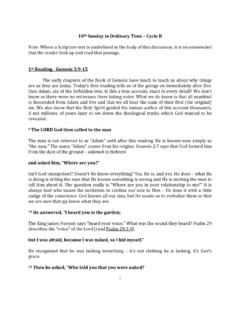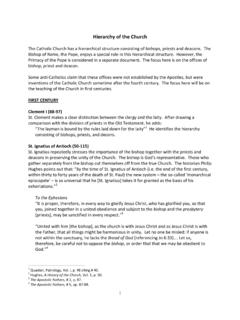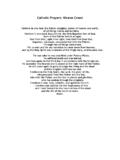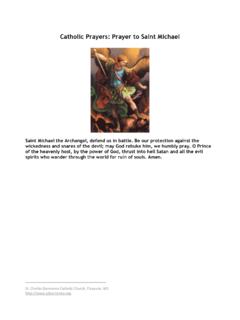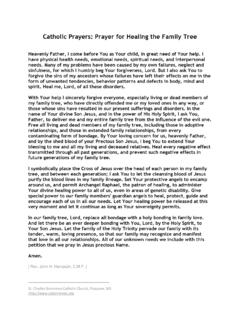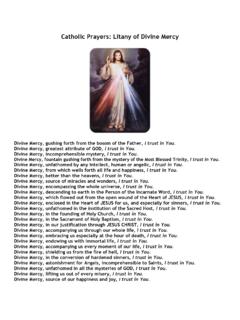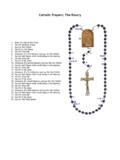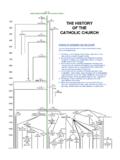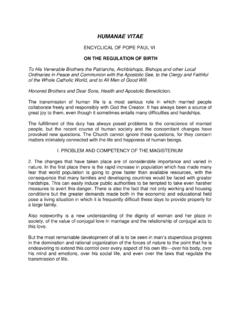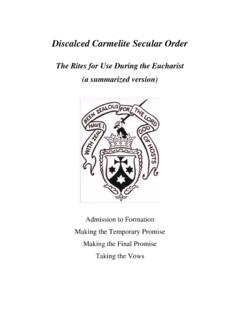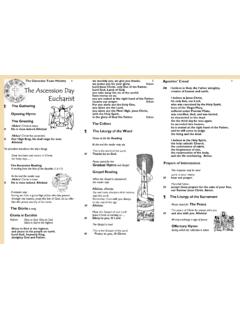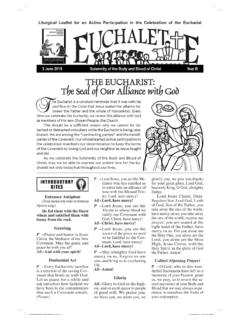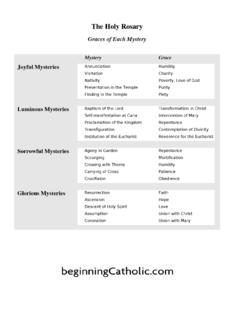Transcription of “This is My Body” The Real Presence of Jesus in the …
1 1 This is My Body The real Presence of Jesus in the eucharist Jesus said, this is my body when he changed bread into his body and blood during the Last Supper. Three of the Gospels report that Jesus used these exact words. St. Paul repeats them in his First Letter to the Corinthians. Their meaning certainly seems clear. Yet with the invention of the principle of individual interpretation, their meaning has been the subject of controversy. Apparently, Jesus words were not so clear to some people. In this essay these four words will be examined. Collectively, the passages that contain these words are called the institution narratives. They provide the simplest way to show that, when Jesus said these words, the bread was miraculously transformed into the substance of his body, blood, soul, and divinity the whole Christ.
2 Mt 26:26-28 Now as they were eating, Jesus took bread, and blessed, and broke it, and gave it to the disciples and said, Take, eat; this is my body. And he took a cup, and when he had given thanks he gave it to them, saying, Drink of it, all of you for this is my blood of the covenant, which is poured out for many for the forgiveness of sins. Mk 14:22-24 And as they were eating, he took bread, and blessed, and broke it, and gave it to them, and said, Take; this is my body. And he took a cup, and when he had given thanks he gave it to them, and they all drank of it. And he said to them, This is my blood of the covenant, which is poured out for many.
3 Lk 22:19-20 And he took bread, and when he had given thanks he broke it and gave it to them, saying, This is my body which is given for you. Do this in remembrance of me. And likewise the cup after supper, saying, This cup which is poured out for you is the new covenant in my blood . 1 Cor 11:23-26 For I received from the Lord what I also delivered to you, that the Lord Jesus on the night when he was betrayed took bread, and when he had given thanks, he broke it, and said, This is my body which is for you. Do this in remembrance of me. In the same way also the cup, after supper, saying, this cup is the new covenant in my blood. Do this, as often as you drink it, in remembrance of me.
4 A recent President of the United States incurred a great deal of notoriety for his failed attempt to parse away the literal meaning of the verb is. With the introduction of Luther s principle of individual interpretation of the Bible in the 16th century, called sola scriptura the Bible alone, passages of Scripture were subjected to outlandish interpretations that bore little 2 relationship to the sacred text and the Christian faith that had been faithfully passed on from Jesus and the apostles for 1,500 years. One example of the confusion that followed is evidenced in Christopher Rasperger s work published in 1577, 200 Interpretations of the Words: This is My Therefore, it is not surprising to find that some contemporary Protestant apologists strive to explain away the clear meaning of the institution narratives.
5 Protestant Objection Robert Zins makes the following claims: In the first place, the word is would do too much if it did what the Catholics think it must do for them. This is My Body would have to make the bread the actual body of Jesus and it would no longer have the properties of bread. It would be his body. The Romanist skirts this issue by saying the bread is Christ in its essence but retains the characteristics of bread in its outward appearance. We ask how any serious Greek exegete can swallow this use of the Greek estin (is)! Where is the Greek language ever used in this manner? 2 Catholic Response There are several flaws to Mr. Zins reasoning.
6 First, Catholic exegetes do not claim that the Greek word estin (is) provides a theological definition for the miracle of transubstantiation. However, when Jesus holds bread in his hands and then says in relationship to what is in his hands: This is my body, Christians should accept the clear meaning of his words. What was bread is now his body regardless of its external appearance. Transubstantiation is merely the apt theological term formulated to explain this marvelous change that takes place. This is precisely Zins real objection, he claims the words, this is my body, are two literal and he refuses to accept the reality of the miracle. Therefore he reinterprets the words of Jesus in the following manner: This [bread] is [symbolizes] my body.
7 Zins, like all those who reject the words of institution, are faced with the undeniable reality that four inspired writers: Matthew, Mark, Luke, and Paul used words that can only mean the bread has changed into the body of Christ. Not one of these inspired authors employed symbolic language in their institution narrative. Therefore those who deny the real physical Presence of Jesus need to substantiate their claim based on the inspired text. However, when the inspired Greek words are analyzed the Catholic understanding is reinforced and Protestant symbolism crumbles. There is no linguistic basis for claiming that is in the institution narratives means symbolizes or that this refers to the bread.
8 Matthew (Mt 26:26), Mark (14:22) and Luke (22:19) use exactly the same Greek words for This is my body . Touto estin to soma mou This is the body of me neuter neuter 1 Not By Bread Alone, p. 146, note 122. 2 Romanism, pp. 124-125. 3 When the text is examined in relationship to Greek grammar employed in the passage, the meaning becomes very clear. Touto (this) is a neuter demonstrative adjective. It can t modify or refer to bread, which is a masculine noun. Instead, it clearly refers to soma (body), which is a nominative neuter noun.
9 Therefore the only possible translation in English is: This [substance in my hands] is my body. St. Paul uses a somewhat different Greek construction in his First Letter to the Corinthians (1 Cor 11:24). Touto mou estin to soma This of me is the body Once again, however, the meaning is very clear. Paul s positioning of mou (of me) strengthens the meaning of touto (this). The text is so clear that Jesus is speaking about his body that it is so reflected in most English translations including Protestant What was bread is bread no longer. It is the whole Jesus . Protestant Objection Mr. Zins offers another objection.
10 Secondly, the word is is used by Jesus to define the New Covenant in His blood. This cup [is] (estin supplied) the New Testament in my blood, which is shed for you (Luke 19:20).4 No one in the Romanist community wants to say the cup is actually the New Covenant. Obviously it is a figure for the New Covenant. Likewise, Paul in 1 Corinthians says, This cup is the new testament in my blood (1 Corinthians 11:25). Here, too, the is estin is used in a figure representing the spiritual truth of a New Covenant having been inaugurated. 5 Catholic Response Mr. Zins misses the figure of speech used in the institution passages by shifting the emphasis from cup to is (estin), which is lacking in the Greek text of the passages he cites.
